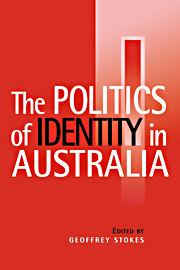Book contents
- Frontmatter
- Contents
- Acknowledgements
- Contributors
- Introduction
- Theorising Identity
- Gender and Sexuality
- Race, Place and Citizenship
- 8 Racialism and Democracy: The Legacy of White Australia
- 9 Immigration and National Identity: Multiculturalism
- 10 Australia and Asia: Place, Determinism and National Identities
- 11 Citzenship and Aboriginality: Two Conceptions of Identity in Aboriginal Political Thought
- Culture: Literature and Film
- References
- Index
10 - Australia and Asia: Place, Determinism and National Identities
Published online by Cambridge University Press: 05 June 2012
- Frontmatter
- Contents
- Acknowledgements
- Contributors
- Introduction
- Theorising Identity
- Gender and Sexuality
- Race, Place and Citizenship
- 8 Racialism and Democracy: The Legacy of White Australia
- 9 Immigration and National Identity: Multiculturalism
- 10 Australia and Asia: Place, Determinism and National Identities
- 11 Citzenship and Aboriginality: Two Conceptions of Identity in Aboriginal Political Thought
- Culture: Literature and Film
- References
- Index
Summary
For most of the last two hundred years, ‘Asia’ and ‘Asianness’ were feared by Australians. Previous Australian discussions of national identity employed the word ‘Asia’ as a dialectical contrast term, consistent with a Romantic poetics (see Hudson 1991). ‘Asia’ and ‘Asians’ were often constructed not only as ‘other’, but as opposite: as cruel, barbarous and treacherous, qualities that supported claims to the apparent superiority of Australian character and the values of British civilisation. Today Australian understandings are generally more refined and the images of Asia are more positive. Such shifts have been prompted as much by greater personal contact, though travel, trade and immigration, as by better academic knowledge.
Indeed, Australia's increasing trade with countries in Asia has provoked a reappraisal of our cultural, economic and political identities. It has been argued that the dependence of Australia's economic security upon trade with Asian countries is a reason for shifting our cultural orientation more towards Asia. Advocates of closer ties with Asia have called upon Australians to learn Asian languages and even to become less critical of human rights abuses among our close neighbours and ‘trading partners’ (see e.g. Nason 1994; Woolcott 1993; Wrigley 1994). Where the ‘shift to Asia’ is presented as valuable, the debate also involves historical priority disputes over who initiated the process (see e.g. Hill 1994; Murray 1993; D. Walker 1994). In the public rhetoric about Australia's relationship to Asia may be found various perceptions of Australian identity, its determinants and what it could or should become.
- Type
- Chapter
- Information
- The Politics of Identity in Australia , pp. 145 - 157Publisher: Cambridge University PressPrint publication year: 1997
- 3
- Cited by

